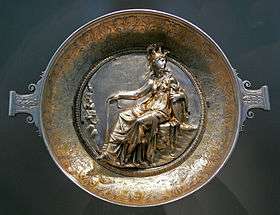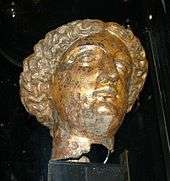Minerva
| Minerva | |
|---|---|
| Goddess of poetry, medicine, wisdom, commerce, weaving, crafts and magic. | |
| Member of the Capitoline Triad | |
 Mosaic of the Minerva of Peace in the Library of Congress | |
| Animals | Owl of Minerva |
| Parents | Jupiter and Metis |
| Greek equivalent | Athena |
| Etruscan equivalent | Minerva |
| Religion in ancient Rome |
|---|
 |
| Practices and beliefs |
| Priesthoods |
| Deities |
|
| Related topics |
Minerva (/mɪˈnɜːr.və/; Latin: [mɪˈnɛr.wa]; Etruscan: Menrva) was the Roman goddess of wisdom and sponsor of arts, trade, and strategy. She was born with weapons from the head of Jupiter.[1] After impregnating the titaness Metis, Jupiter recalled a prophecy that his own child would overthrow him. Fearing that their child would grow stronger than he and rule the Heavens in his place, Jupiter swallowed Metis whole. The titaness forged weapons and armor for her child while within the father-god, and the constant pounding and ringing gave him a headache. To relieve the pain, Vulcan used a hammer to split Jupiter's head and, from the cleft, Minerva emerged, whole, adult, and bearing her mother's weapons and armor. From the 2nd century BC onwards, the Romans equated her with the Greek goddess Athena.[2] She was the virgin goddess of music, poetry, medicine, wisdom, commerce, weaving, crafts, and magic.[3] She is often depicted with her sacred creature, an owl usually named as the "owl of Minerva",[4] which symbolised her association with wisdom and knowledge.
Etruscan Menrva
Stemming from an Italic moon goddess *Meneswā ('She who measures'), the Etruscans adopted the inherited Old Latin name, *Menerwā, thereby calling her Menrva. It is assumed that her Roman name, Minerva, is based on this Etruscan mythology. Minerva was the goddess of wisdom, war, art, schools and commerce. She was the Etruscan counterpart to Greek Athena. Like Athena, Minerva was born from the head of her father, Jupiter (Greek Zeus).
By a process of folk etymology, the Romans could have linked her foreign name to the root men- in Latin words such as mens meaning "mind", perhaps because one of her aspects as goddess pertained to the intellectual. The word mens is built from the Proto-Indo-European root *men- 'mind' (linked with memory as in Greek Mnemosyne/μνημοσύνη and mnestis/μνῆστις: memory, remembrance, recollection, manush in Sanskrit meaning mind).
Worship in Rome

The Etruscan Menrva was part of a holy triad with Tinia and Uni, equivalent to the Roman Capitoline Triad of Jupiter-Juno-Minerva. Minerva was the daughter of Jupiter.
As Minerva Medica, she was the goddess of medicine and doctors. As Minerva Achaea, she was worshipped at Lucera in Apulia where votive gifts and arms said to be those of Diomedes were preserved in her temple.[5][6]

In Fasti III, Ovid called her the "goddess of a thousand works". Minerva was worshipped throughout Italy, and when she eventually became equated with the Greek goddess Athena, she also became a goddess of battle. Unlike Mars, god of war, she was sometimes portrayed with sword lowered, in sympathy for the recent dead, rather than raised in triumph. In Rome her bellicose nature was emphasized less than elsewhere.[7] Her worship was also spread throughout the empire—in Britain, for example, she was syncretized with the local goddess Sulis, who was often invoked for restitution for theft.[8]
The Romans celebrated her festival from March 19 to March 23 during the day which is called, in the neuter plural, Quinquatria, the fifth after the Ides of March, the nineteenth, an artisans' holiday . A lesser version, the Minusculae Quinquatria, was held on the Ides of June, June 13, by the flute-players, who were particularly useful to religion. In 207 BC, a guild of poets and actors was formed to meet and make votive offerings at the temple of Minerva on the Aventine Hill. Among others, its members included Livius Andronicus. The Aventine sanctuary of Minerva continued to be an important center of the arts for much of the middle Roman Republic.
Minerva was worshipped on the Capitoline Hill as one of the Capitoline Triad, at the Temple of Minerva Medica, and at the "Delubrum Minervae", a temple founded around 50 BC by Pompey on the site now occupied by the church of Santa Maria sopra Minerva. When it was founded, the emperor himself was present and was believed to be of divine nature as a result of its construction.
Universities and educational establishments
As a patron goddess of wisdom, Minerva frequently features in statuary, as an image on seals, and in other forms at educational institutions.
Use by societies and governments

- The Seal of California depicts the Goddess Minerva. Her having been born fully-grown symbolizes California having become a state without first being a territory.[9]
- In the early 20th century, Manuel José Estrada Cabrera, President of Guatemala, tried to promote a "Worship of Minerva" in his country; this left little legacy other than a few interesting Hellenic style "Temples" in parks around Guatemala.
- According to John Robison's Proofs of a Conspiracy (1798), the third degree of the Bavarian Illuminati was called Minerval or Brother of Minerva, in honour of the goddess of learning. Later, this title was adopted for the first initiation of Aleister Crowley's OTO rituals.
- Minerva is displayed on the Medal of Honor, the highest military decoration awarded by the United States government.
- Minerva is featured in the logo of the Max Planck Society.
- Minerva alongside Mars is displayed on the cap badge of the Artists Rifles Territorial SAS Regiment of the British Army. A regimental rhyme records: "Mars, he was the God of war, and didn't stop at trifles. Minerva was a bloody whore. So hence The Artists' Rifles."
- Kingston Upon Hull's oldest Masonic Lodge is named The Minerva Lodge.
- Minerva is the patron goddess of the Theta Delta Chi and Sigma Alpha Epsilon fraternities, the Phi Theta Kappa Honor Society, and the Kappa Kappa Gamma and Delta Sigma Theta[10] sororities
- Minerva is featured on the Union College seal. The college motto is "We all become brothers under the laws of Minerva."
- Minerva is an Institute for training for SSB Interviews and written examinations like NDA, CDS .It is situated in Sector 120,Mohali,Punjab.It is the first and oldest Armed Forces Preparatory Institute in India and established in 1955.
- LSV Minerva is the oldest student society in the Netherlands and strongly related to Leiden University.
Public monuments, places and modern culture
- A statue of Minerva is displayed at the University of North Carolina Greensboro and is the university's new graphic identity starting 2004.
- A small Roman shrine to Minerva stands in Handbridge, Chester. It sits in a public park, overlooking the River Dee.
- Also in the UK the town hall of Liverpool has recently restored it's statue of Minerva. http://www.liverpoolecho.co.uk/news/liverpool-town-halls-minerva-statue-7931451
- The Minerva Roundabout in Guadalajara, Mexico, located at the crossing of the López Mateos, Vallarta, López Cotilla, Agustín Yáñez and Golfo de Cortez avenues, features the goddess standing on a pedestal, surrounded by a large fountain, with an inscription which says "Justice, wisdom and strength guard this loyal city".
- A bronze statue of Minerva lies in monument square Portland, Maine. "Our Lady of Victories Monument" dedicated 1891, Richard Morris Hunt and Franklin Simmons.
- A sculpture of Minerva by Andy Scott, known as the Briggate Minerva, stands outside Trinity Leeds shopping centre.
- Minerva is displayed as a statue in Pavia, Italy, near the train station, and is considered as an important landmark in the city.
- Minerva is the name of a supercomputer at the Icahn School of Medicine at Mount Sinai in New York City.
- On the summit of the dome of Liverpool Town Hall in England is a statue, representing Minerva. It is 10 feet (3 m) high and was designed by John Charles Felix Rossi. The present Liverpool Town Hall containing the statue was begun in 1749.
- Minerva is the song title of a single and the third track on the Deftones self-titled album released May 20, 2003.
- Minerva is a reoccurring character in the Assassin's Creed franchise as a guide to Desmond and later a potential foil for Juno, a main antagonist for the series.
- Minerva, along with her Greek counterpart Athena are gods in the Japanese mobile game Puzzle & Dragons
- Minerva is displayed as a cast bronze statue in the Hennepin County Library Central Library, in Minneapolis Minnesota.
- A statue of Minerva is displayed at the University of North Carolina Greensboro.
- Minerva is displayed as a 7-ft statue in the Science Library at the State University of New York at Albany and is on the official academic seal of the University.[11]
- Minerva is displayed as a bronze statue in Frederick Ruckstull's 1920 Altar to Liberty: Minerva monument near the top of Battle Hill, the highest point of Brooklyn, NY, in Green-Wood Cemetery.
See also
References and sources
- References
- ↑ Encarta World English Dictionary 1998-2004 Microsoft Corporation.
- ↑ Larousse Desk Reference Encyclopedia, The Book People, Haydock, 1995, p. 215.
- ↑ Candau, Francisco J. Cevallos (1994). Coded Encounters: Writing, Gender, and Ethnicity in Colonial Latin America. University of Massachusetts Press. p. 215. ISBN 0-87023-886-8.
- ↑ Philosophy of Right (1820), "Preface"
- ↑ Aristotle Mirab. Narrat. 117
- ↑ Schmitz, Leonhard (1867). "Achaea (2)". In Smith, William. Dictionary of Greek and Roman Biography and Mythology. 1. Boston. p. 8.
- ↑ Mark Cartwright. "Minerva". Ancient History Encyclopedia.
- ↑ R. S. O. Tomlin (1992). "Voices from the Sacred Spring" (PDF). Bath History. 4: 8, 10.
- ↑ http://www.sos.ca.gov/digsig/greatseal.htm
- ↑ http://www.deltasigmatheta.org/downloads/vendors/list%20of%20registered%20marks.pdf
- ↑ "University at Albany - SUNY -". albany.edu.
- Sources
- Origins of English History see Chapter Ten.
- Romans in Britain - Roman religion and beliefs see The Roman gods.
- Old Norse Myths, Literature and Society
 This article incorporates text from a publication now in the public domain: Smith, William, ed. (1870). "article name needed". Dictionary of Greek and Roman Biography and Mythology.
See page 1090
This article incorporates text from a publication now in the public domain: Smith, William, ed. (1870). "article name needed". Dictionary of Greek and Roman Biography and Mythology.
See page 1090
External links
| Wikisource has the text of the 1911 Encyclopædia Britannica article Minerva. |
 The dictionary definition of Minerva at Wiktionary
The dictionary definition of Minerva at Wiktionary Media related to Minerva at Wikimedia Commons
Media related to Minerva at Wikimedia Commons- Roman Mythology

